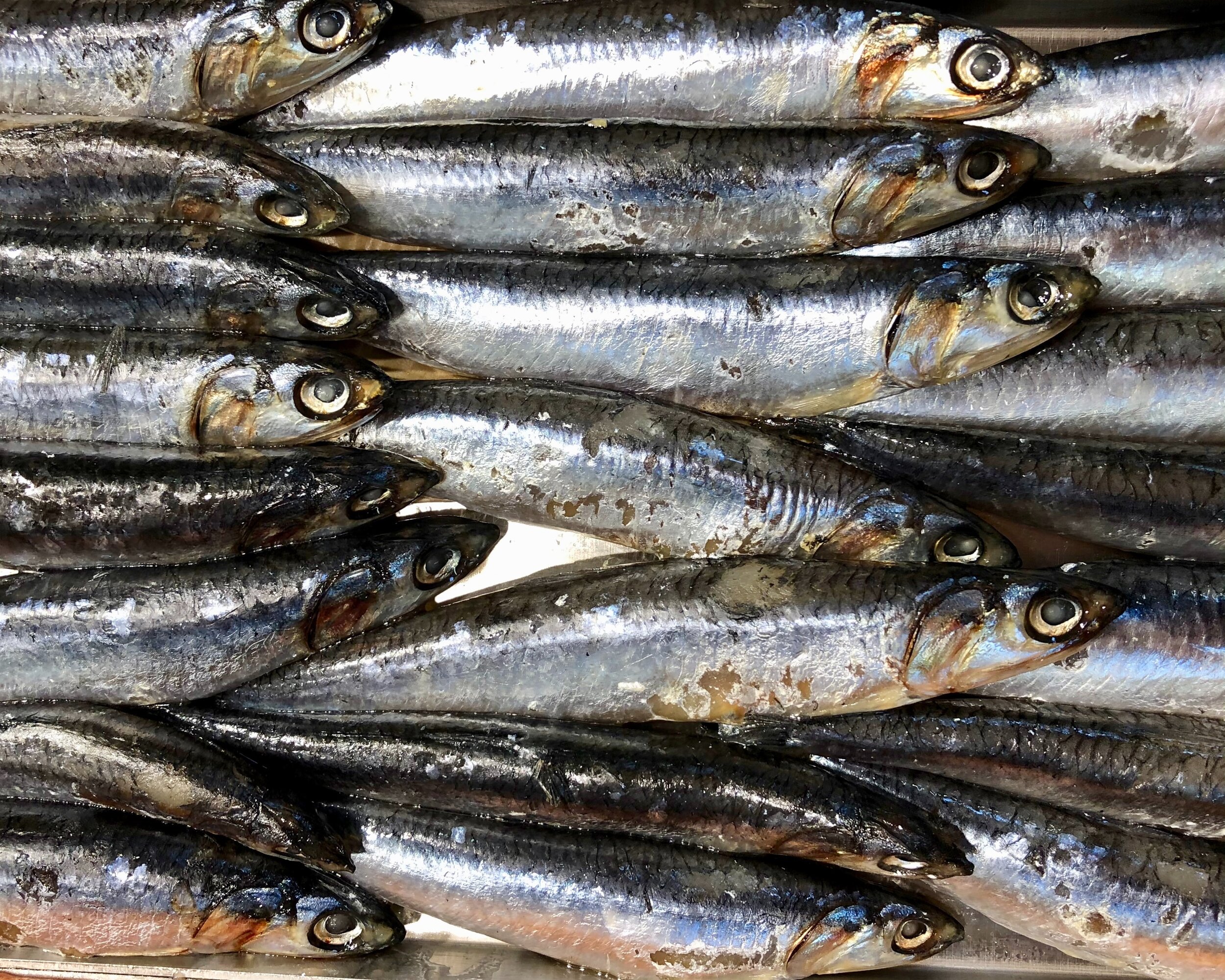Fish Oil: Who is it for?
Fresh anchovies. Photo by Diane Helentjaris via Unsplash.
We’ve all heard that fish oil is good for us. But what exactly is in fish oil? Fish oil is a natural source of the omega-3 fatty acids DHA and EPA, both of which have been studied extensively for a variety of possible human health benefits, notably in relation to cardiovascular health [1, 2, 3].
Ideally, humans get these essential nutrients from direct consumption of fish rather than fish oil capsules. The largest user of fish oil is actually the aquaculture industry (e.g. farmed fish, shrimp, and other carnivorous aquatic species), which consumed roughly 80% of the global supply in 2009 [3]. Other avenues for fish oil use include pet food, terrestrial animal feed, and infant formula.
Fish oil is produced by separating and extracting the solid and liquid components of whole fish or leftover scraps from fish processing, such as head, meat, and bones. Whole fish material usually comes from anchovies, menhaden, and other lower-value species that don’t have a well-developed food market. Common species for byproduct sourcing include pollock, salmon, tuna, herring, and mackerel, but these are still underutilized [4].
A study in 2016, for example, found that there was an estimated 11.7 M ton of fish byproduct from wild fisheries and aquaculture operations that was discarded [4]. As fish consumption is projected to increase over the next decade, we will likely be generating a lot more fish processing byproducts as well, primarily from aquaculture [4].
In order to minimize our waste/footprint on this planet, we want to ensure we are using our resources as efficiently as possible by finding uses for every part of every fish landed and farmed. Our volumes of wasted fish will increase unless we find viable market avenues, including innovative new uses for fish oil that can increase demand for its production.
There is a push in recent years to find alternatives to wild-caught fish for aquaculture fish feed. Initiatives like the Fish Free Feed (F3) Challenge and Proterra Foundation are working to spur responsible innovation in this new sector. Soy, algae, soldier fly, and yeast-based fish feed are examples of alternatives that are being actively explored [5]. These developments are incredibly exciting, but even alternatives may have to address environmental concerns, such as habitat removal, footprint of agricultural practices, land-use conflicts, and human labor rights to name a few [5].
An additional alternative to traditional fish feed is sitting right in front of us: fish byproduct leftovers from the processing of high-value species, such as tuna, to generate value-added fish oil products. Production of fish oil requires large quantities of a single species of fish, existing infrastructure and machinery to press, heat, and extract the oil, and the ability to quickly preserve and transport the product, since fish scraps deteriorate very rapidly.
Currently, the types of companies contributing raw material to fish oil byproduct production are larger-scale processing plants that are subsidiaries of a major or global family company. Not only is fish byproduct generated by those already positioned to process them economically, but it also doesn’t need any bioengineering to generate the nutritional requirements needed to meet aqua feed needs.
Some major seafood producers are already doing this. Thai Union, a large global tuna cannery, is looking to reduce waste in their fish processing facilities by expanding into the fish oil market [6]. Cooke Seafood and Keep Grays Harbor Fishing are two examples of large corporate seafood businesses made up of subsidiary companies, including both fish processing and fish oil manufacturing.To get a sense of scale, Ocean Protein, a subsidiary company of Keep Grays Harbor Fishing, is producing about 670 metric ton of fish oil annually. Using the estimate that 5% of raw material could be turned into fish oil, that’s about 13,400 metric ton of fish raw material a year [4].
Griswold inspecting his wild-caught salmon oil. Photo by Iwen Su.
By tapping into this opportunity, existing large-scale fish processing operations can reduce waste, create a supplementary market opportunity, and skip a large part of the R&D typically needed for developing new feed products. As demand for fish oil products grows and more value-added fish oil products appear (e.g. pet supplements), there will likely be increased opportunities for smaller, medium-sized fish processors to provide high quality fish raw material [4].
Personally, I have never spent much time in the fish oil aisle. I get most of my omega-3 nutrients directly from eating fish. However, for those who don’t eat fish regularly, it is a really easy way to add omega-3s (DHA and EPA) into your diet. When I adopted my quarantine pup a month ago, his foster sent us home with an MSC-certified, wild-caught salmon oil food supplement. It took him a few days to get comfortable in his new home, and he was quite timid around his food bowl.
Except when I lathered his kibble in salmon oil. Oh, he absolutely loved it. His coat feels smoother, too. Either way, I don’t think we can go back now. If the kibble we give him doesn’t already contain omega-3 or DHA in it, I will absolutely be getting him some fish oil as a topper. In the future, I hope to see different kinds of fish oil, not just salmon, not just wild-caught, not just single species fish oil. Who doesn’t like options?
References
National Center for Complementary and Integrative Health (2018). Omega-3 Supplements: In Depth. National Institutes of Health, U.S. Department of Health and Human Services.
Higdon, Jane (2003). Essential fatty acids. Linus Pauling Institute, Oregon State University. Updated by Donald B. Jump, June 2019. Retrieved April 19, 2021.
Toppe, Jogeir. Farmed fish: a major provider or a major consumer of omega-3 oils?. Food and Agriculture Organization of the United Nations.
Jackson, A and Newton RW (2016). Project to model the use of fisheries byproduct in the production of marine ingredients, with special reference to the omega 3 fatty acids EPA and DHA. Institute of Aquaculture, University of Stirling, UK and International Fishmeal and Fish Oil Organisation, The Marine Ingredients Organisation.
Jackson, Lisa (2021). Soy helped build aquaculture into a global force. How far can it take it? Global Aquaculture Alliance.
Janssen, Peter (2019). Thai Union aims to turn tuna heads into gold. Nikkei Asia.



